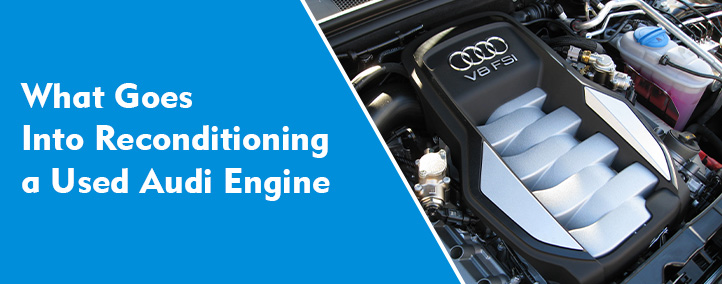
What Goes Into Reconditioning a Used Audi Engine
Although the reconditioning process of every engine is almost same, but there are practices which are limited to certain brands only. This is because every internal combustion engine works on the same principles of mechanics and thermodynamics, but each brand makes tweaks in the engine which are specific to their needs, same is the case with a used Audi engine or a reconditioned Audi engine.
Reconditioning usually involves steps like inspection, machining, replacement of worn parts and reassembling them, and they are common in almost every brands engine. But reconditioned Audi engine has some steps which are limited to Audi engines only.
Used engine restoration for Audi has the following steps which are different from others:
1. Turbochargers and Direct Injection System
- Turbochargers add extra power and performance in Audi engines, but they also add complexity which in turn makes the engines reconditioning process complicated and long. Majority of the time these turbochargers has to be taken separately and different inspection processes are involved in their checking. As you know turbochargers use the exhaust gasses, hence the carbon build up in these is massive. This carbon build can be cleaned only by chemical cleaning or media blasting. These processes are quite time taking and has high complexity.
- All of this is a consequence of direct injection system, as the fuel comes in direct contact of the engine, the fumes and smoke pile up in the chamber and in the long run creates a mess. Engines with non-direct fuel injection system do not have this problem, due to this time and money both are saved in during their reconditioning.
2. Unique Timing System
- Audi engines use timing chains instead of belts usually, because timing chains give smoother shifting than belts, but also have a complicated structure. This makes them tricky for restoration. A used Audi Engine’s restoration is a cumbersome task due to this as well.
- These chains are multi stage, i.e. have a quite intricate network of parts, especially in V6 and V8 engines, that are famous for their power delivery. These chains play a crucial role in this; hence they had to be taken care of, properly. This is why taking them apart takes more time and labor.
- Many rear mounted timing components require full engine removal, which sounds time consuming in itself.
3. High Tolerance of Parts
- Performance models of Audi like S and RS have engines that have high tolerance for temperature, pressure and other types of strains. As they are made with precision tolerance, they cannot be machined by ordinary tools, special tools are needed in such cases to get reconditioned Audi engine.
- Only an experienced mechanic has the skill to all the machining, because these toughen parts can easily bent out of shape if not worked on properly. Finding a quality mechanic is time consuming task as well.
4. Aluminum Blocks
Restoring a used Audi engine involves more than just replacing worn components—it requires careful attention to Audi’s unique engineering, particularly its aluminum block construction. Audi engines often feature aluminum alloy blocks and heads, which are lighter but more sensitive than cast iron. During used engine restoration, torque specs have to be followed perfectly to avoid warping the entire block. Machining the cylinder walls require high-precision techniques to maintain the engine’s structural strength. A misstep here can result in any of the two, either a costly performance issues or premature failure. Only experienced technicians can handle the restoration process for these types of engines.
5. Electronics and Sensors
Audi engines are also heavily dependent on advanced electronics and a variety of sensors. When reconditioning a used engine, it’s not enough to rebuild the mechanical parts only; the electronic systems must be properly recalibrated as well, because they work closely with mechanical parts of the engine. ECU and integrated components like camshaft sensors, knock sensors, and variable valve timing units are a key part of used engine restoration. Audi involves ensuring these sensors communicate correctly to avoid triggering error codes or causing engine misfires. Failure to reset or sync these systems properly can render an otherwise well-restored engine unusable. This also increases engine restoration time and cost more labour.
6. Match of OEM Parts and Software
Another critical element of restoring a used Audi engine is using OEM (Original Equipment Manufacturer) parts and software-matching procedures. Audi engines are sensitive to part compatibility and digital programming. During used engine restoration, technicians often need to re-flash the ECU or reprogram many computer systems of the vehicle to match its VIN. Component IDs must be correctly paired with the control modules of the car to ensure smooth operation. Skipping these steps can lead to software conflicts, drivability issues, or even total failure to start the engine after installation. This is hard for a new or inexperienced mechanic. You have to find someone with ample knowledge of computer systems and electric circuits. This can take some time as well
Final Conclusion
While the basic process of engine reconditioning is universal, the above mentioned steps are specific only to Audi or VAG. A used Audi engine demands greater technical skills that are to find. We at carengineguru.com always make sure that the reconditioning process of Audi engines is done only by the best. You can check or listings of used Audi engines and make an assessment yourself. To know more, use our websites form and lock your quote today! We will talk to you as soon as you fill out the form with your requirement.
